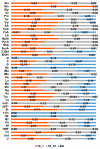A Preliminary Study of Chemical Profiles of Honey, Cerumen, and Propolis of the African Stingless Bee Meliponula ferruginea
- PMID: 34063246
- PMCID: PMC8147412
- DOI: 10.3390/foods10050997
A Preliminary Study of Chemical Profiles of Honey, Cerumen, and Propolis of the African Stingless Bee Meliponula ferruginea
Abstract
Recently, the honey and propolis of stingless bees have been attracting growing attention because of their health-promoting properties. However, studies on these products of African Meliponini are still very scarce. In this preliminary study, we analyzed the chemical composition of honey, two cerumen, and two resin deposits (propolis) samples of Meliponula ferruginea from Tanzania. The honey of M. ferruginea was profiled by NMR and indicated different long-term stability from Apis mellifera European (Bulgarian) honey. It differed significantly in sugar and organic acids content and had a very high amount of the disaccharide trehalulose, known for its bioactivities. We suggested trehalulose to be a potential marker for African stingless bee honey analogously to the recent proposal for Meliponini honey from Asia, South America, and Australia and demonstrated its easy discrimination by 13C NMR. Propolis and cerumen were studied by GC-MS (gas chromatography-mass spectometry). The samples contained mainly terpenoids (di-and triterpenes) but demonstrated qualitative and quantitative differences. This fact was an indication that possibly M. ferruginea has no strict preferences for resins used to construct and protect their nests. The antimicrobial and anti-quorum sensing properties of the two materials were also tested. These first results demonstrated that the honey, cerumen, and propolis of African stingless bees were rich in biologically active substances and deserved further research.
Keywords: African Meliponini; anti-quorum sensing; antimicrobial; cerumen; chemical profiling; pot-honey; propolis; stingless bees.
Conflict of interest statement
The authors declare no conflict of interest. The funders had no role in the design of the study; in the collection, analyses, or interpretation of data; in the writing of the manuscript; or in the decision to publish the results.
Figures







Similar articles
-
Cerumen of Australian stingless bees (Tetragonula carbonaria): gas chromatography-mass spectrometry fingerprints and potential anti-inflammatory properties.Naturwissenschaften. 2011 Apr;98(4):329-37. doi: 10.1007/s00114-011-0770-7. Epub 2011 Feb 24. Naturwissenschaften. 2011. PMID: 21347735
-
Propolis of stingless bees: A phytochemist's guide through the jungle of tropical biodiversity.Phytomedicine. 2021 Jun;86:153098. doi: 10.1016/j.phymed.2019.153098. Epub 2019 Sep 27. Phytomedicine. 2021. PMID: 31648904 Review.
-
Stingless Bee-Collected Pollen (Bee Bread): Chemical and Microbiology Properties and Health Benefits.Molecules. 2021 Feb 11;26(4):957. doi: 10.3390/molecules26040957. Molecules. 2021. PMID: 33670262 Free PMC article. Review.
-
Stingless bee honey, a novel source of trehalulose: a biologically active disaccharide with health benefits.Sci Rep. 2020 Jul 22;10(1):12128. doi: 10.1038/s41598-020-68940-0. Sci Rep. 2020. PMID: 32699353 Free PMC article.
-
The Chemical Composition of Scaptotrigona mexicana Honey and Propolis Collected in Two Locations: Similarities and Differences.Foods. 2023 Sep 3;12(17):3317. doi: 10.3390/foods12173317. Foods. 2023. PMID: 37685249 Free PMC article.
Cited by
-
Identifying Key Markers for Monofloral (Eucalyptus, Rosemary, and Orange Blossom) and Multifloral Honey Differentiation in the Spanish Market by UHPLC-Q-Orbitrap-High-Resolution Mass Spectrometry Fingerprinting and Chemometrics.Foods. 2024 Aug 29;13(17):2755. doi: 10.3390/foods13172755. Foods. 2024. PMID: 39272519 Free PMC article.
-
Optical Rotation-A Reliable Parameter for Authentication of Honey?Molecules. 2022 Dec 15;27(24):8916. doi: 10.3390/molecules27248916. Molecules. 2022. PMID: 36558078 Free PMC article.
-
The Role of Propolis as a Natural Product with Potential Gastric Cancer Treatment Properties: A Systematic Review.Foods. 2023 Jan 16;12(2):415. doi: 10.3390/foods12020415. Foods. 2023. PMID: 36673507 Free PMC article. Review.
-
Evaluation of the polyphenolic profile of native Ecuadorian stingless bee honeys (Tribe: Meliponini) and their antibiofilm activity on susceptible and multidrug-resistant pathogens: An exploratory analysis.Curr Res Food Sci. 2023 Jun 29;7:100543. doi: 10.1016/j.crfs.2023.100543. eCollection 2023. Curr Res Food Sci. 2023. PMID: 37455680 Free PMC article.
-
Differences in the biochemical content and radical scavenging activity of propolis from different parts of a Meliponula ferruginea hive.R Soc Open Sci. 2023 Dec 13;10(12):230241. doi: 10.1098/rsos.230241. eCollection 2023 Dec. R Soc Open Sci. 2023. PMID: 38094264 Free PMC article.
References
-
- Sanches M.A., Pereira A.M.S., Serrão J.E. Pharmacological actions of extracts of propolis of stingless bees (Meliponini) J. Apicult. Res. 2017;56:50–57. doi: 10.1080/00218839.2016.1260856. - DOI
-
- Chanchao C. Antimicrobial activity by Trigona laeviceps (stingless bee) honey from Thailand. Pak. J. Med. Sci. 2009;25:364–369.
-
- Lavinas F.C., Macedo E.H.B., Sá G.B., Amaral A.C.F., Silva J.R., Azevedo M.M., Vieira B.A., Domingos T.F.S., Vermelho A.B., Carneiro C.S., et al. Brazilian stingless bee propolis and geopropolis: Promising sources of biologically active compounds. Rev. Bras. Farmacogn. 2019;29:389–399. doi: 10.1016/j.bjp.2018.11.007. - DOI
-
- Biesmeijer J.C., Hartfelder K., Imperatriz-Fonseca V.L. Stingless bees: Biology and management. Apidologie. 2006;37:121–123. doi: 10.1051/apido:2006020. - DOI
Grants and funding
LinkOut - more resources
Full Text Sources
Miscellaneous

